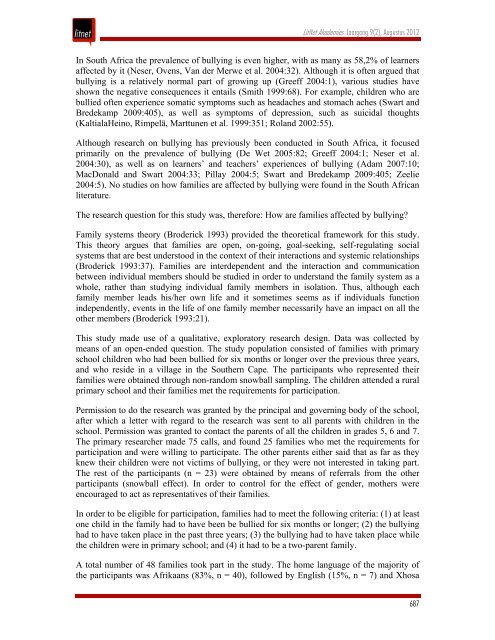Klik hier om die artikel in PDF-formaat - LitNet
Klik hier om die artikel in PDF-formaat - LitNet
Klik hier om die artikel in PDF-formaat - LitNet
Create successful ePaper yourself
Turn your PDF publications into a flip-book with our unique Google optimized e-Paper software.
<strong>LitNet</strong> Akademies Jaargang 9(2), Augustus 2012<br />
In South Africa the prevalence of bully<strong>in</strong>g is even higher, with as many as 58,2% of learners<br />
affected by it (Neser, Ovens, Van der Merwe et al. 2004:32). Although it is often argued that<br />
bully<strong>in</strong>g is a relatively normal part of grow<strong>in</strong>g up (Greeff 2004:1), various stu<strong>die</strong>s have<br />
shown the negative consequences it entails (Smith 1999:68). For example, children who are<br />
bullied often experience s<strong>om</strong>atic sympt<strong>om</strong>s such as headaches and st<strong>om</strong>ach aches (Swart and<br />
Bredekamp 2009:405), as well as sympt<strong>om</strong>s of depression, such as suicidal thoughts<br />
(KaltialaHe<strong>in</strong>o, Rimpelä, Marttunen et al. 1999:351; Roland 2002:55).<br />
Although research on bully<strong>in</strong>g has previously been conducted <strong>in</strong> South Africa, it focused<br />
primarily on the prevalence of bully<strong>in</strong>g (De Wet 2005:82; Greeff 2004:1; Neser et al.<br />
2004:30), as well as on learners’ and teachers’ experiences of bully<strong>in</strong>g (Adam 2007:10;<br />
MacDonald and Swart 2004:33; Pillay 2004:5; Swart and Bredekamp 2009:405; Zeelie<br />
2004:5). No stu<strong>die</strong>s on how families are affected by bully<strong>in</strong>g were found <strong>in</strong> the South African<br />
literature.<br />
The research question for this study was, therefore: How are families affected by bully<strong>in</strong>g?<br />
Family systems theory (Broderick 1993) provided the theoretical framework for this study.<br />
This theory argues that families are open, on-go<strong>in</strong>g, goal-seek<strong>in</strong>g, self-regulat<strong>in</strong>g social<br />
systems that are best understood <strong>in</strong> the context of their <strong>in</strong>teractions and systemic relationships<br />
(Broderick 1993:37). Families are <strong>in</strong>terdependent and the <strong>in</strong>teraction and c<strong>om</strong>munication<br />
between <strong>in</strong>dividual members should be stu<strong>die</strong>d <strong>in</strong> order to understand the family system as a<br />
whole, rather than study<strong>in</strong>g <strong>in</strong>dividual family members <strong>in</strong> isolation. Thus, although each<br />
family member leads his/her own life and it s<strong>om</strong>etimes seems as if <strong>in</strong>dividuals function<br />
<strong>in</strong>dependently, events <strong>in</strong> the life of one family member necessarily have an impact on all the<br />
other members (Broderick 1993:21).<br />
This study made use of a qualitative, exploratory research design. Data was collected by<br />
means of an open-ended question. The study population consisted of families with primary<br />
school children who had been bullied for six months or longer over the previous three years,<br />
and who reside <strong>in</strong> a village <strong>in</strong> the Southern Cape. The participants who represented their<br />
families were obta<strong>in</strong>ed through non-rand<strong>om</strong> snowball sampl<strong>in</strong>g. The children attended a rural<br />
primary school and their families met the requirements for participation.<br />
Permission to do the research was granted by the pr<strong>in</strong>cipal and govern<strong>in</strong>g body of the school,<br />
after which a letter with regard to the research was sent to all parents with children <strong>in</strong> the<br />
school. Permission was granted to contact the parents of all the children <strong>in</strong> grades 5, 6 and 7.<br />
The primary researcher made 75 calls, and found 25 families who met the requirements for<br />
participation and were will<strong>in</strong>g to participate. The other parents either said that as far as they<br />
knew their children were not victims of bully<strong>in</strong>g, or they were not <strong>in</strong>terested <strong>in</strong> tak<strong>in</strong>g part.<br />
The rest of the participants (n = 23) were obta<strong>in</strong>ed by means of referrals fr<strong>om</strong> the other<br />
participants (snowball effect). In order to control for the effect of gender, mothers were<br />
encouraged to act as representatives of their families.<br />
In order to be eligible for participation, families had to meet the follow<strong>in</strong>g criteria: (1) at least<br />
one child <strong>in</strong> the family had to have been be bullied for six months or longer; (2) the bully<strong>in</strong>g<br />
had to have taken place <strong>in</strong> the past three years; (3) the bully<strong>in</strong>g had to have taken place while<br />
the children were <strong>in</strong> primary school; and (4) it had to be a two-parent family.<br />
A total number of 48 families took part <strong>in</strong> the study. The h<strong>om</strong>e language of the majority of<br />
the participants was Afrikaans (83%, n = 40), followed by English (15%, n = 7) and Xhosa<br />
687
















